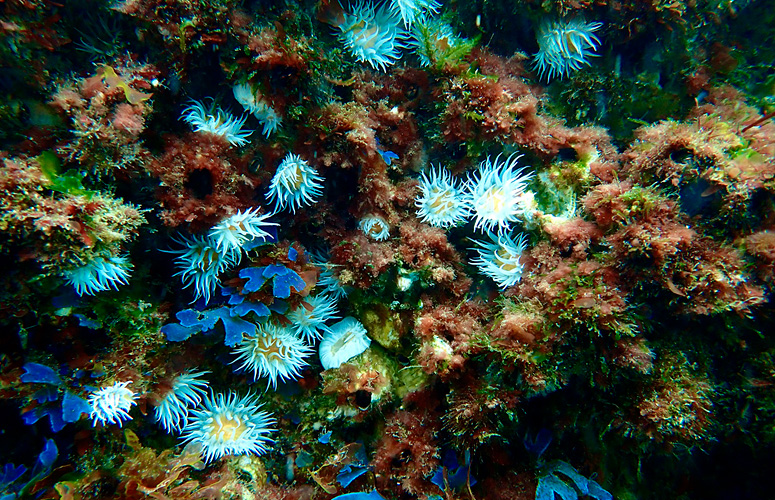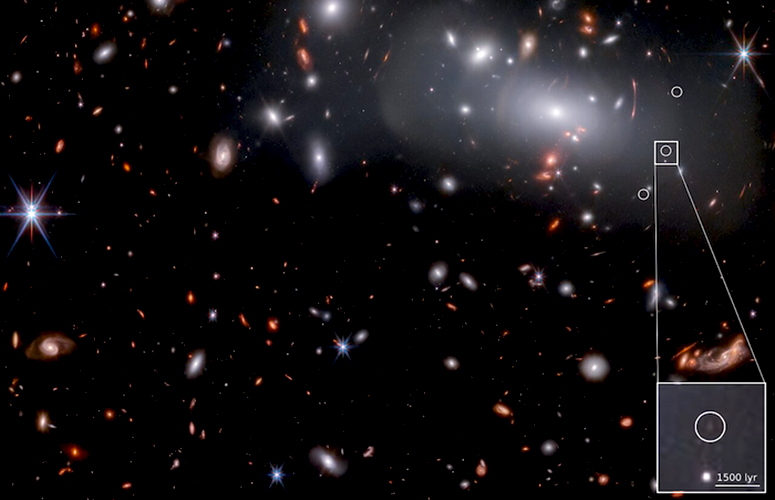Discovery of the most distant dwarf galaxy detected so far
- Research
First publication date: 18/04/2023

- Ikerbasque Research Professor of the UPV/EHU and associate of DIPC Tom Broadhurst is part of the international team that serendipitously found this galaxy that formed only 500 million years after the Big Bang
- The observation was made using the James Webb Space Telescope and has been published in the journal Science
An international team, including the Ikerbasque research professor of the University of the Basque Country (UPV/EHU) and associate of Donostia International Physics Center (DIPC) Tom Broadhurst, used the high resolution of the James Webb Space Telescope (JWST) combined with a powerful gravitational lens to conclude that the galaxies that formed in the early universe were typically very small, indicating a hierarchical process of evolution from dwarf galaxies gradually merging together as a result of mutual gravity, until massive galaxies such as our Milky Way were formed. The study has just been published in the journal Science.
By analysing the spectra of several galaxies in the distant Universe, the team was also able to confirm the detection of the most distant dwarf galaxy found to date. As Broadhurst explains, “this tiny, very low luminosity galaxy is one of the first to form, only 500 million years after the Big Bang, when the volume of the Universe was about a thousand times smaller than it is today.”
Broadhurst is part of an international team with a large allocation of JWST time for the study of stars and galaxies in the distant universe through gravitational lensing, a method that uses massive objects, such as clusters of galaxies, to magnify in brightness and size the targets behind them. Earlier this year, the team had already measured the spectrum of several stars and galaxies using this technique, “and we were very excited when we detected this very high redshift galaxy.” The latest observations enabled the team to confirm that “the distance estimate of this galaxy is 100% reliable, because we were able to recognise distinctive elements in its spectrum, such as hydrogen, carbon, oxygen and neon, which come from its hot gas.”
A lucky strike
Measurements of the size of this galaxy have revealed that it is a very low-brightness dwarf galaxy located 13.2 billion light years away. These measurements were made “thanks to the high-resolution of the James Webb Telescope combined with the magnification power of a massive cluster of galaxies located in the foreground which acts as a giant lens”, explained the professor. Broadhurst is an experienced spectroscopist and an expert in gravitational lensing, so his work has involved “interpreting the spectrum and estimating the amplification of this galaxy by using a model of the gravitational field of the large cluster of galaxies acting as a lens in this case.”
As the researcher explained, “this galaxy was not our primary target, but fortunately it appeared in the images obtained with the James Webb, so we decided to add it to our list of targets for follow-up spectroscopy.” This serendipitous discovery has led the team to conclude that “it is highly possible this type of small low luminosity dwarf galaxy is typical of the first galaxies to form in the early Universe, rather than the bright galaxies claimed by other groups that do not use gravitational lensing.”
Bibliographical reference
The paper “A magnified compact galaxy at redshift 9.51 with strong nebular emission lines”, has been published in Science on 13 April 2023, DOI: 10.1126/science.adf5307
Hayley Williams, Patrick L. Kelly, Wenlei Chen, Gabriel Brammer, Adi Zitrin, Tommaso Treu, Claudia Scarlata, Anton M. Koekemoer, Masamune Oguri, Yu-Heng Lin, Jose M. Diego, Mario Nonino, Jens Hjorth, Danial Langeroodi, Tom Broadhurst, Noah Rogers, Ismael Perez-Fournon, Ryan J. Foley, Saurabh Jha, Alexei V. Filippenko, Lou Strolger, Justin Pierel, Frederick Poidevin, and Lilan Yang





